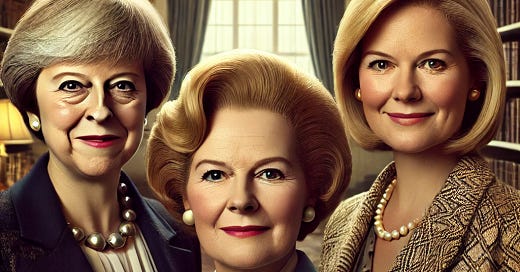In the past few decades, Britain has had three female prime ministers.
In May 1979, Margaret Thatcher, the daughter of a grocer, rose to the top of politics to become the first female prime minister of the country. Thatcher was at the helm of the country as it entered a war in the Atlantic to retake the Falkland Islands from Argentina. 255 British soldiers lost their lives, alongside 649 from Argentina.
Fast-forward to July 2016, when Theresa May took over from David Cameron, who resigned following the defeat of the Brexit vote.
Liz Truss became prime minister, taking office on 6 September 2022, the fourth Conservative PM since 2010. Truss presided over the most disastrous mini-budget in history and remained as prime minister for just 50 days, the shortest-serving prime minister the country had seen. The enduring memory of Truss will be that a lettuce outlasted her as PM, although she failed to see the funny side.
And that brings us to the question of who will be number four.
The present prime minister, Sir Keir Stammer, took office in July this year and looks set for a five-year term. His deputy is Angela Rayner.
The Conservative Party fell apart after the election and has been fighting to regain some semblance of control ever since. With just 121 elected MPs, the Conservatives are still the formal opposition, although leader Rishi Sunak resigned following the election defeat.
Of the 121 remaining Conservative members of parliament, less than a quarter, 29, are female. The Liberal Democrats have more at 32, making up over 44% of the party, with Labour around the same percentage with 186 female members.
That gives the Conservative Party a relatively small pool of talent for the next leader to be female, let alone become prime minister. Last week, the party confirmed their new leader to be Kemi Badenoch, who took to the despatch box on the House of Commons on Wednesday for her first prime minister’s question time. Her first performance was less than stellar.
It is hard to see a Conservative party leader and, by default, leader of the opposition, lasting five years and challenging Labour for power. This is principally because the party seems hellbent on replacing leaders faster than a cup of tea goes cold.
At some point before the next election, sometime in mid-2029, if the timetable stands, who could replace Badenoch from the female side of the party and be victorious? Leaving aside the guys for the moment, there is a remaining pool of 28 to choose from.
The name who rose to the top of political minds is Priti Patel (now shadow foreign secretary), who was defeated in the recent leadership election. Laura Trott (shadow education secretary) is another contender, and Victoria Atkins (shadow environment secretary) is also a candidate. All are in the new Badenoch shadow cabinet.
These three will have reasonably high profiles going forward, with Priti Patel perhaps the best known to the public as things stand. Even if one of these three replaces Badenoch before the next election, there are no guarantees that they will be handed the keys to number ten.
It is interesting to speculate how long Sir Keir Starmer will remain as PM and leader of his party. His first 100 days in office were dogged with problems, from the withdrawal of the winter fuel allowance for pensioners to the scandal over £16,000 of free clothing for him and his wife. Although none of these were enough early in his tenure for these to be calls to move aside, what other hazards await him over the next five years?
Let’s say that something comes along that trips Starmer up, and he cannot recover. His most apparent replacement currently is his deputy Angela Rayner.
At the age of 44, Rayner could well be the next leader of Labour, and who knows, will we see the party’s first female prime minister?
Angela Rayner - Prime Minister. I’m sure she thinks it has a certain ring to it.
Article voiceover
Discussion about this post
No posts



